


 |
 |
Harley-Davidson 45 Standard, WLDR & WR Transmission Ratios
Ratio Calculations
Harley-Davidson 45 3-speed transmission’s intermediate gears (1st & 2nd) are the result of the transmission of power through two pairs of mating gears, the 1st pair of which (high gear) is the clutch gear being turned by the countershaft high gear (on the cluster). The high gear internal ratio is the product of the high gear tooth counts.
The 2nd number is the product of the pair of gears (mainshaft + countershaft) for that ratio. The intermediate gear ratio is determined by multiplying the 1st and 2nd ratios together.
In 3rd (high) gear the clutch gear is locked to the mainshaft, so no power is transmitted through the gears, and the ratio is 1.000:1 (direct). Although the intermediate gears still turn, they’re only idling.
Since 1935, there have been four different ratio gearsets used: two standard and two close-ratio. Please note that there are size differences between the components, and direct substitution of an alternate gear (early to late, close to standard, etc.) to provide additional an ratio selection is generally not possible.
Factors Affecting Ratio Choice
“Range” is the torque multiplication difference between 1st gear and high gear (3rd or 4th); wider-ratio gear-sets have more, typically between 2.6 and
3.1. This is the single most important determinant of low-speed acceleration.
“Progression” is the next factor. This is the reduction or decay in the percentage drop in engine speed in the next gear (e.g. after shifting from 1st to 2nd). Most transmissions have some degree of progression in that the RPM drop on the 1-2 shift is larger than
the RPM drop on the 2-3 shift (which would be in turn larger than the RPM drop on the 3-4 shift). The progression may not be linear (continuously reduced) or done in proportionate stages for various reasons, including a special need for a gear to reach a specific speed or RPM for passing, racing, etc. or simply economic necessity: the parts were available.
The two factors are not mutually exclusive, but each limits the number of options for the other. A wide range, which gives a strong torque multiplication in 1st gear for excellent manners in low-speed traffic (especially with a heavy chassis or side-car) mean that the progression percentages must all be high. The amount of engine
speed (and therefore power) that must be lost on each up-shift is higher than would be the case in a transmission with less range (but less power in 1st gear). A numerically low 1st gear (2.046:1, &c.) reduces available torque in 1st gear, but allows more choices of progression.
Smaller motors, big cams, big ports or carburetors don’t pull well from low rpm, and when the 2-3 shift takes place at a speed where air resistance is high (70+ MPH), closer ratios are better and the factory (wide-ratio) gear-set is at a big disadvantage with its 36% RPM drop (5,000 RPM drops to 3,182). Close ratio boxes are an improvement under these conditions, but have the disadvantage of less torque multiplication in 1st.
Below are some useful ratio tables, how they are generated internally, and their effects on performance. Click here to see the big twin tables:  . .
Standard Ratios
For the 1935-40 standard (& 1933-34 reverse-gear) transmissions, the high gear tooth counts are: 21 for the main drive gear and 13 for the clutch gear, so the 1st number is always 1.615385 for the 1935-40 standard ratio transmission.
For the 1941-73 standard transmission, the high gear tooth counts are: 22 for the main drive gear and 14 for the clutch gear; the 1st number is always 1.571429 for the 1941-73 standard ratio transmission.
|
1935-40 Standard Ratio Calculation |
Components |
Teeth MS |
Teeth CS |
21/13 × |
Ratio |
1st gear |
21 |
13 |
21/13 |
2.609:1 |
2nd gear |
17 |
17 |
17/17 |
1.615:1 |
3rd gear |
13 (clutch gear) |
21 |
(locked) |
1.000:1 |
1941-73 Standard Ratio Calculation |
Components |
Teeth MS |
Teeth CS |
22/14 × |
Ratio |
1st gear |
22 |
14 |
22/14 |
2.469:1 |
2nd gear |
18 |
18 |
18/18 |
1.571:1 |
3rd gear |
14 (clutch gear) |
22 |
(locked) |
1.000:1 |
1941-73 Standard Ratio RPM Loss on Shift |
Ratio |
1st |
RPM Drop to 2nd
|
2nd |
RPM Drop to 3rd
|
3rd |
Standard |
2.469 |
36.4% |
1.571 |
36.4% |
1.000 |
Close Ratios
The first 45 factory transmission with different internal ratios for performance use was introduced in 1939. The 1939-40 WLDR “special” and 1942-52 WR close ratios differ from the standard 1935-40 and 1941-73 transmission ratios only in one respect: the high gear ratio. This means that the ratio spread and consequent RPM drop has been “closed up” on both shifts by moving 1st and 2nd closer to 3rd, which substantially reduces 1st gear acceleration, and makes these gear sets unsuitable for normal use.
WLDR “Special” Ratio
The 1939-40 WLDR special ratio countershaft high gear is 19 and the clutch gear is 15, so the 1st number is always 1.266667 for the special ratio transmission. |
WLDR Special Ratio Calculation |
Components |
Teeth MS |
Teeth CS |
19/15 × |
Ratio |
1st gear |
21 |
13 |
21/13 |
2.046:1 |
2nd gear |
17 |
17 |
17/17 |
1.267:1 |
3rd gear |
15 (clutch gear) |
19 |
(locked) |
1.000:1 |
WR Close Ratio
The 1942-52 WR close ratio countershaft high gear is 20 and the clutch gear is 16, so the 1st number is always 1.25 for the close ratio transmission. |
WR close ratio calculation |
Components |
Teeth MS |
Teeth CS |
20/16 × |
Ratio |
1st gear |
22 |
14 |
22/14 |
1.964:1 |
2nd gear |
18 |
18 |
18/18 |
1.250:1 |
3rd gear |
16 (clutch gear) |
20 |
(locked) |
1.000:1 |
WR RPM loss on shift |
Ratio |
1st |
RPM Drop to 2nd
|
2nd |
RPM Drop to 3rd
|
3rd |
Standard |
1.964 |
20% |
1.250 |
20% |
1.000 |
Frantisek Jiracek (Czech) 4-Speed
The Jiracek 4-speed countershaft high gear is 27 and the clutch gear is 19, so the 1st number is always 1.421053 for this transmission. Here’s his site:  . Click on the image for a larger view. . Click on the image for a larger view. |
|
|
Jiracek 4-Speed Ratio Calculation |
Components |
Teeth MS |
Teeth CS |
27/19 × |
Ratio |
1st gear |
30 |
16 |
30/16 |
2.664:1 |
2nd gear |
27 |
19 |
27/19 |
2.019:1 |
3rd gear |
23 |
23 |
23/23 |
1.421:1 |
4th gear |
19 (clutch gear) |
27 |
(locked) |
1.000:1 |
Jiracek 4-Speed RPM loss on shift |
Ratio |
1st |
RPM Drop to 2nd
|
2nd |
RPM Drop to 3rd
|
3rd |
RPM Drop to 4th
|
4th |
Standard |
2.664 |
24% |
2.019 |
30% |
1.421 |
30% |
1.000 |
An Alternate 3 Speed Gear Set
Let me suggest a useful improvement for the 1941-73 transmission for use in any 45 that needs better high speed power. A possible alternate gear set for the original 1941-* transmission can be made by the substitution of different gears for the 2nd gear pair only. Unfortunately, this will require fabrication since 1 gear is part of the cluster gear, and the other has a shift clutch recess in its inner face.
The existing 2nd gear pair is 18/18. If a new 17 tooth gear (made from an Andrews Products 2.44 mainshaft 1st gear or commercial gear, on a 45 original gear for the shift clutch slots?) is substituted for the original 18 tooth gear (35294-41) on the mainshaft, and the original 45 reverse gear (35284-41) is swapped from the mainshaft and welded or keyed to the countershaft in place of the existing reverse countershaft gear, the new pair is 17/19. Needless to say, this is much cheaper than trying to fabricate a WR cluster and clutch gear (splines, 4 gears, tapers, threads). Unfortunately, the new 2nd gear position is “reverse” on the shift gate, since the shift cam will be difficult to modify.
This will leave the existing std. ratio 1st gear at 2.469:1 (with the same acceleration), but move 2nd away from 1st and closer to 3rd at 1.406:1, so the new RPM drops are “staged” to favor a closer ratio when it’s needed - at high speed. |
1-2 shift: | Std. 36.4% RPM drop (5,000 > 3,180) | Alt. 43.1% RPM drop (5,000 > 2,845) |
2-3 shift: | Std. 36.4% RPM drop (5,000 > 3,180) | Alt. 28.9% RPM drop (5,000 > 3,555) |
1941-73 alternate ratio calculation |
Components |
Teeth MS |
Teeth CS |
22/14 × |
Ratio |
1st gear |
22 |
14 |
22/14 |
2.469:1 |
2nd gear |
17 |
19 |
17/19 |
1.406:1 |
3rd gear |
14 (clutch gear) |
22 |
(locked) |
1.000:1 |
1941-73 alternate ratio RPM loss on shift |
Ratio |
1st |
RPM Drop to 2nd
|
2nd |
RPM Drop to 3rd
|
3rd |
Standard |
2.469 |
43.1% |
1.406 |
28.9% |
1.000 |
British 4, 5 & 6 Speed Gear Sets
Before spending quite a bit of money to make a 4-speed from a WL box, there are many more choices of ratio spread available by converting to a BSA, Norton or Triumph pre-unit transmission. Click here for my booklet:  . .
Read more about the optional factory ratios for all these brands: BSA  , Norton , Norton  , Triumph , Triumph  . .
Triple Cycles  and Quaife and Quaife  can supply very close 4-speed gear sets, and 5 & 6 speed conversions for the Norton & Triumph. can supply very close 4-speed gear sets, and 5 & 6 speed conversions for the Norton & Triumph. |
|
Overdrive transmission
If you already have a tall rear tire and tried a 34 tooth motor sprocket and either the engine is too "busy" or you want to go even faster (above 100), change the rear wheel to use a different sprocket that doesn't go outside the drum, like a Honda 350 or any disc brake.
If you want to keep the original parts, and overdrive will help, but it's a PITA.
The problem with overdrive is that high gear in most transmissions is direct (no gears transmit power, they're still touching but they "freewheel"), and the shift clutch (or dog) just locks the output gear (holding the sprocket) to the mainshaft (holding the clutch) so there is no ratio at all.
An overdrive would need its high gear to be a "normal" gear (the result of power transmitted across the shafts twice), but with a final number less than 1.00, like .8 or .9. This leaves 3rd as direct (1.00:1), and 1st & 2nd can be where they are now. Of course, the shift drum positions are wrong...
I don't know if the shaft center distance of a 45 matches anything else, which may make using Sportster or big twin gears possible.
The easiest way to make an OD, using as many stock parts as possible, is to use the existing reverse position (since it has a drum slot, and shift clutch). The reverse idler and its shaft (which spins the output gear backward) come out.
Instead, another, smaller gear is substituted for the 19 tooth reverse (35284-41) on the mainshaft (you can't use the original, because it doesn't mesh with the countershaft reverse gear, only with the reverse idler gear). The new mainshaft gear must have its hub machined to match the shift clutch recess on the reverse gear (or the tooth row attached to the existing hub).
The stock 14 tooth reverse gear is part of the cluster, and it's the wrong size. To get an overdrive ratio, it's got to go the other way: bigger. This requires the existing gear to be ground off, and another (with the same tooth pattern) to be welded or key to the countershaft gear.
A useful ratio, keeping the same 36 tooth gear total, can be made from a 13 tooth (but where to get one? a reverse idler is 13...) and a 23 tooth (Andrews close 3rd mainshaft gear?) substituted for the reverse gear, making the final drive .8882:1. This reduces engine speed by this amount, changing a 34 tooth into the equivalent of a 38 tooth, and increasing top speed by 12.6%. A 12/24 combination is too much change, a 14/22 does nothing.
This also makes the shift into overdrive even closer than the WR shift into high gear, so it's actually useful for racing.
It just takes a lot of work.
|
3-Speed + overdrive ratio calculation |
Components |
Teeth MS |
Teeth CS |
27/19 × |
Ratio |
1st gear |
22 |
14 |
22/14 |
2.469:1 |
2nd gear |
18 |
18 |
18/18 |
1.571:1 |
3rd gear |
14 (clutch gear) |
22 |
(locked) |
1.000:1 |
Overdrive |
13 |
23 |
|
.888:1 |
3-Speed + overdrive RPM loss on shift |
Ratio |
1st |
RPM drop to 2nd
|
2nd |
RPM drop to 3rd
|
3rd |
RPM drop to OD
|
4th |
Standard |
2.469 |
36% |
1.571 |
36% |
1.000 |
11% |
.888 |
See these other Victory Library booklets |
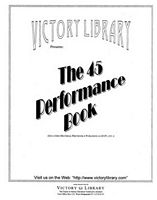
|

|

|
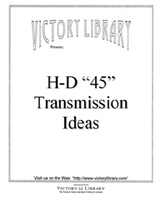
|
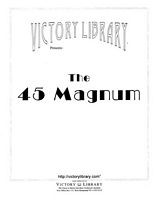
|
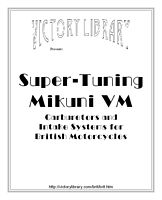
|
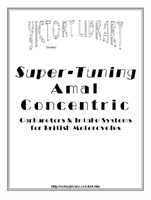
|
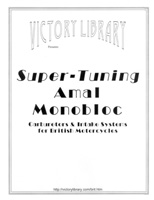
|
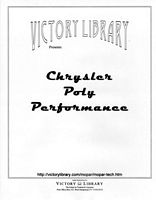
|

|
Click here for Harley-Davidson stroker flywheels |
Knuckle, Panhead
1941-54 |
Pan, Shovelhead
1955-71 |
Shovelhead
1972-81 |
45 WL, trike
1937-73 |
74, 80” Flathead
1937-48 |
Sportster
1957-* |
|
|
|
|
|
|
|
|
|
|
|
|
|
|
|
| |
|
|
|



